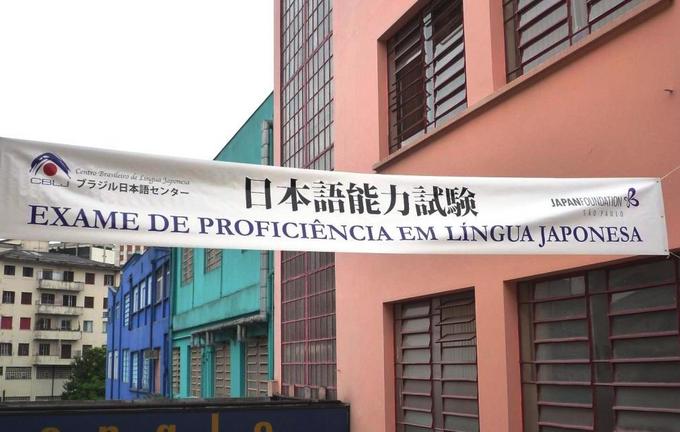The Car That Carries the Future of the Japanese Language--The New Japanese-Language Proficiency Test (JLPT)
Naomi Takasu
Acting Managing Director of the Japan Foundation Center for Japanese-Language Testing
"I've just about given up! Everything's buried in snow and all public transport has been shut down....
"A parade came out of nowhere and is clogging the roads!"
"The university has been besieged by a student protest!!"
"One of our examinees has wilted in the sweltering heat!"
"The f-firetruck's siren...."
"Nooo...there's an o-orchestra at the zoo n-next door!"
These cries arrive from all over the world around the day before the test. Most are questions about postponing the test start time or problems with noise during the listening section of the test, but as these phone calls come from all over the world with no regard for time differences, the staff in Japan dare not let their cell phones out of their sight. The staff carries their phones with them when they go to the restroom, when they take a bath, and even keep them within arm's reach when they sleep. Then they have nightmares of the batteries dying or stepping on and breaking the phones, and wake up. During a large student protest in Italy, the students holed up in the university and took over the classroom where the test was to be administered. Staff members of the Istituto Giaponnese di Cultura in Roma were distraught, and recklessly (but courageously) entered the university by themselves and frantically negotiated with the students. "We get it now. Our enemy is the administration, not Japan. We'll get out. Thus, the test was held in the classroom as scheduled. People here still talk about the incident, which we named "Operation Get Out of the Way."

A long line forms at the reception desk on the day of the exam (Manila)
The number of examinees skyrockets, the staff works to keep up
The Japanese Language Proficiency Test (JLPT) was created in 1984 and is conducted jointly by the Japan Foundation and Japan Educational Exchanges and Services to evaluate and certify the Japanese proficiency of non-native Japanese speakers. Initially, there were about 7,000 examinees who took the test in 21 cities in 15 countries/areas. By the late 1990s, though, the number of both test sites and examinees had skyrocketed. In 2009, 25 years since the test had begun, it gathered 770 thousand examinees from 206 cities in 54 countries/areas, and had grown into the largest-scale Japanese-language test. Originally, the test was designed not to "fail" examinees but to "make them pass," but examinees may appear desperate, because the percentage of examinees certified at the highest level is roughly 30%, which can hardly be called high. Also, they can receive their scores and can find out if they passed or not, and test results are used for entering universities, finding jobs, securing promotions and for admission into universities in Japan. *1
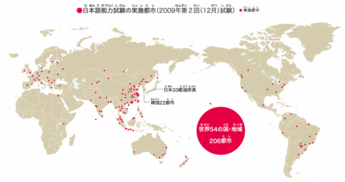
 The staff doesn't have a moment to breathe even after the test is over. They must check the flood of answer sheets that come pouring in. The younger members of the staff gather to face the daunting task of comparing the errors to the proctor reports they receive from all over the world, and fixing the errors that the machines can't handle. They look at several hundred errors, which include examinee registration numbers that have been incorrectly filled in and proctors forgetting to mark an examinee as absent, and then check with individual local host institutions to make sure the data is correct. By the time they have fixed all the errors, the staff is completely worn out. After all, even while they are checking the errors, they receive e-mails like "My student cries. They put different registration number down. What to do? I wander about" almost daily from Japanese-language teachers in various countries. Replying with "That's all right, we've already found and fixed the error" doesn't do much good either--then they'll receive a reply that says something like "My student cries again. This time, cries with joy...." On top of that, by this time, the preparation of the application forms and posters for the next test is at a peak. The staff must also choose the new test sites. In this way, the never-ending journey of the Center for Japanese-Language Testing continues.
The staff doesn't have a moment to breathe even after the test is over. They must check the flood of answer sheets that come pouring in. The younger members of the staff gather to face the daunting task of comparing the errors to the proctor reports they receive from all over the world, and fixing the errors that the machines can't handle. They look at several hundred errors, which include examinee registration numbers that have been incorrectly filled in and proctors forgetting to mark an examinee as absent, and then check with individual local host institutions to make sure the data is correct. By the time they have fixed all the errors, the staff is completely worn out. After all, even while they are checking the errors, they receive e-mails like "My student cries. They put different registration number down. What to do? I wander about" almost daily from Japanese-language teachers in various countries. Replying with "That's all right, we've already found and fixed the error" doesn't do much good either--then they'll receive a reply that says something like "My student cries again. This time, cries with joy...." On top of that, by this time, the preparation of the application forms and posters for the next test is at a peak. The staff must also choose the new test sites. In this way, the never-ending journey of the Center for Japanese-Language Testing continues.
Revising the test and administering it twice a year--Selling points of the new JLPT
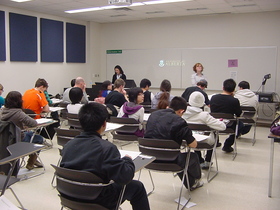 This ritual has been repeated every December for 25 years. It's been held twice a year, in July and December, since 2009. In 2010, the new Japanese-Language Proficiency Test which focuses on measuring the communicative competence required to perform tasks was born. It introduced a new question format that evaluate an examinee's ability to perform in new sections that require more than simple memorization, including integrated comprehension, quick response, information retrieval, and increased the number of levels from 4 levels to 5 levels. For all five levels, the evaluation of each examinee's abilities in "language knowledge (characters, vocabulary and grammar)," "reading" and "listening" is used to determine whether or not the examinee has passed. Results and scores are then mailed to each examinee. N1 is the most difficult level, and N5 is the easiest. All questions are multiple-choice and answers are written on an answer sheet. Scoring(0-180 points) is not by raw score (how many answers were correct) but by scaled score*2. The process of creating-testing-scoring-certifying-notifying is done twice a year for all 5 levels. The never-ending journey is taking on aspects of a 24-hour endurance race.
This ritual has been repeated every December for 25 years. It's been held twice a year, in July and December, since 2009. In 2010, the new Japanese-Language Proficiency Test which focuses on measuring the communicative competence required to perform tasks was born. It introduced a new question format that evaluate an examinee's ability to perform in new sections that require more than simple memorization, including integrated comprehension, quick response, information retrieval, and increased the number of levels from 4 levels to 5 levels. For all five levels, the evaluation of each examinee's abilities in "language knowledge (characters, vocabulary and grammar)," "reading" and "listening" is used to determine whether or not the examinee has passed. Results and scores are then mailed to each examinee. N1 is the most difficult level, and N5 is the easiest. All questions are multiple-choice and answers are written on an answer sheet. Scoring(0-180 points) is not by raw score (how many answers were correct) but by scaled score*2. The process of creating-testing-scoring-certifying-notifying is done twice a year for all 5 levels. The never-ending journey is taking on aspects of a 24-hour endurance race.
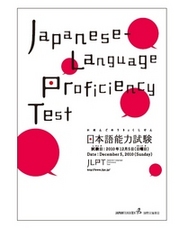

The logo and poster was selected for the Applied Typography 2010 in two categories: Logotype and Symbol, and Graphics.
The scene of the new JLPT--The precision machinery industry of culture
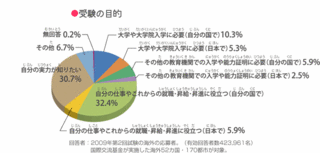 Imagine that the Center for Japanese-Language Testing is where a car called the new JLPT is manufactured. The wheels of the car are theories to evaluate language education and the practice of Japanese language education. The goal is to get as many good users as possible. To achieve that, it is necessary to 1) do market research and product development, 2) do product design and product planning, 3) acquire high-quality materials and parts, and 4) painstakingly put together those parts. It definitely is a culture of Monozukuri (the art of making things) and, in some ways, is similar to the precision machinery industry. Never take process management and quality control lightly. Any delays past the deadline will not be allowed. There mustn't be a single defective product. New car models must be released twice a year, in July and December, and quality and performance must be guaranteed. I always think that there isn't a more demanding industry anywhere else.
Imagine that the Center for Japanese-Language Testing is where a car called the new JLPT is manufactured. The wheels of the car are theories to evaluate language education and the practice of Japanese language education. The goal is to get as many good users as possible. To achieve that, it is necessary to 1) do market research and product development, 2) do product design and product planning, 3) acquire high-quality materials and parts, and 4) painstakingly put together those parts. It definitely is a culture of Monozukuri (the art of making things) and, in some ways, is similar to the precision machinery industry. Never take process management and quality control lightly. Any delays past the deadline will not be allowed. There mustn't be a single defective product. New car models must be released twice a year, in July and December, and quality and performance must be guaranteed. I always think that there isn't a more demanding industry anywhere else.
To make a good car, it is vital to use the newest technology, like item response theory (IRT), cognitive linguistics and language corpora/databases, as well as the intuition, the knack, or the "feeling in the fingertips" that has been created in the field of Japanese language education. The users are the people who learn, teach, and use Japanese in various learning environments around the world. All of them use the JLPT to achieve their goals, whether it is to test their own abilities, to get into a university, to get a job or promotion, to set learning goals or to incorporate the test into educational programs. The needs and demands of these users know no bounds. JLPT is a vehicle that draws out the future possibilities of the Japanese language.

Left: Examinees head to the test site (Bangkok)
Right:Studying hard in the halls up to the last minute before the test (Manila)
Measuring proficiency--Toward the future of the Japanese language
The "P" in JLPT stands for proficiency. It might be translated as "level of mastery" or "skillfulness," but it is the degree to which learners can use Japanese in their daily lives to do things they want to do--watch anime, read manga, understand the news, conduct business talks, read Haruki Murakami's books, study Japanese history, and so on. Proficiency is not only about being able to understand Japanese, but about the ability to use their knowledge of the language that they learned in their future lives--in other words, it's the ability to look to the future. The new JLPT's focus on communicative competency is a means to achieve that. Proficiency is about knowing the rules and the structure of the Japanese language and making the most of that knowledge to read, listen to, write and speak. It's the energy to keep climbing the steps in a series of intellectual operations by using the Japanese language to complete tasks. Once a learner completes a task, the steps to the next task become clear. There will be more and more things they want to do, which will become broader and require new sets of skills. Young people who thought they would be satisfied with being able to read manga may want to read Haruki Murakami's books. Others who only wanted to watch anime might begin wanting to listen to the news, read newspapers or understand the Japanese culture and various aspects of the society behind the anime.
JLPT has never revealed the percentage of examinees certified by country. Neither has it posted a list of examinees that passed by rank. That's because the original goal of this test wasn't about competition between countries or even the learners themselves. It was about each individual learner building on things they could do in Japanese for the future by being a good user of JLPT. It was also about forging deeper connections with more people and opening their eyes to different cultural backgrounds, ways of thinking and new values, and by doing so strengthening ties for the future. The new JLPT has built on the old test to start anew as a test that looks to the future. Proficiency is nurtured when a learner discovers his or her intellectual interests, finds a motive to learn by him or herself and creates a sustainable chain of intellectual curiosity. The car called the new JLPT is just beginning to run with the futures of the learners and the Japanese language.
*1 Japanese-Language Proficiency Test website "JLPT in Charts"
*2 A scaled score scales each individual examinee's scores based on a common scale in order to measure the examinee's ability using the same standard regardless of when they take the test. It quantifies the examinee's ability as a value independent of the difficulty level of each test. For example, it's the same as saying if you scored 108 on the TOEFL, you have a score of 108 on the TOEFL no matter when you took the test. The only difference is that the TOEFL only has one level, and there is no passing or failing. It might be said that the JLPT is, in effect, a TOEFL with 5 levels that lets you know whether or not you passed.
For details see http://www.jlpt.jp/e/about/pdf/scaledscore_e.pdf
* A summary of the new Japanese-Language Proficiency Test and scaled scores can be found in the January and February 2011 editions of Nihongogaku [Japanese Linguistics] magazine. (See below)
Lee Jae-ho, "Nihongo Nouryoku Shiken no Chosen--Atarashii Nihongo Nōryoku Shiken wo Reini" [The challenge of the Japanese-Language Proficiency Test--The example of the new JLPT], Nihongogaku 30-1 (2011): 95-107.
Ikko Kawahashi, "Atarashii Nihongo Nouryoku Shiken no Chosen--Shin Shiken wo Sasaeru Tesuto Riron--" [The challenge of the new Japanese-Language Proficiency Test--The test theory behind the new JLPT], Nihongogaku 30-2 (2011): 80-92.
A message from Mohammed Ansarul Alam, who was the first to pass the new JLPT test at the N1 level in Bangladesh (originally written in Japanese)
 I think the test measures not only the meaning of words, but how to use them--in other words, it measures how well you can communicate. Many of the words in the questions for the N1 test were ones I had used in my daily life. Learners who plan to take the new JLPT must practice using actual Japanese. They must put themselves in a variety of situations where communication is required and try to understand the Japanese language. There are about 40 students in my class, and it's hard for the teacher to exchange words with every student. It is important, though, for students to be the center of classroom activities and for them to listen seriously to what their teachers and classmates have to say. I want people learning the Japanese language all over the world to understand both the meaning and usage of the language, and to continue having fun studying Japanese."
I think the test measures not only the meaning of words, but how to use them--in other words, it measures how well you can communicate. Many of the words in the questions for the N1 test were ones I had used in my daily life. Learners who plan to take the new JLPT must practice using actual Japanese. They must put themselves in a variety of situations where communication is required and try to understand the Japanese language. There are about 40 students in my class, and it's hard for the teacher to exchange words with every student. It is important, though, for students to be the center of classroom activities and for them to listen seriously to what their teachers and classmates have to say. I want people learning the Japanese language all over the world to understand both the meaning and usage of the language, and to continue having fun studying Japanese."
(Alam began studying Japanese as a sophomore in college, and passed the N1 level test in 2010. He also participated in The Japanese Language Program for University Student Groups. He currently teaches at the University of Dhaka.)
Related Events
Back Issues
- 2025.7.31 HERALBONY's Bold Mis…
- 2024.10.25 From Study Abroad in…
- 2024.5. 2 People-to-People Exc…
- 2022.11. 1 Inner Diversity<3> <…
- 2022.9. 5 Report on the India-…
- 2022.6.24 The 48th Japan Found…
- 2022.6. 7 Beyond Disasters - …
- 2021.3.10 Crossing Borders, En…
- 2020.7.17 A Millennium of Japa…
- 2020.3.23 A Historian Interpre…


